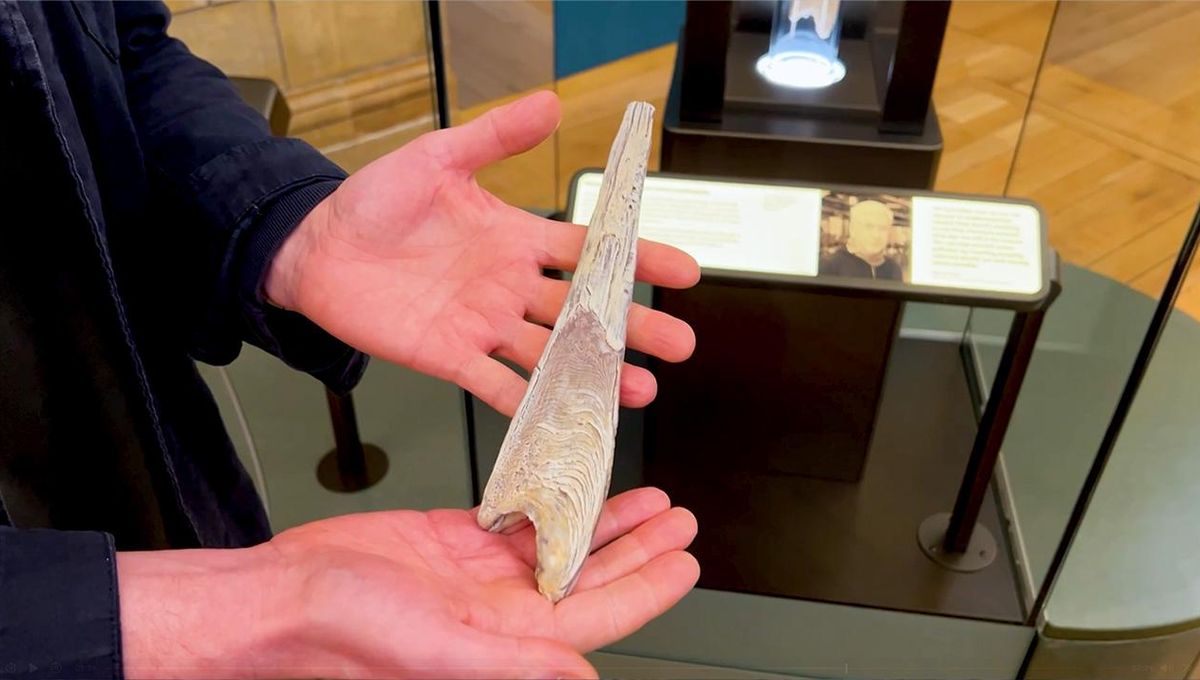
“[It’s] the gift that keeps giving,” Richard Sabin, Principal Curator in the mammals group at the Natural History Museum, London, told us recently when we visited the museum’s new permanent gallery, How To Fix Our Broken Planet. “It’s like it’s a comedy material – and who knew that there would be so much science in there?” He is talking, believe it or not, about whale earwax.
As bizarre as it sounds, this unexpected and unappetizing substance is actually a gold mine of information, which can tell us all sorts of things about the animal it belonged to, as well as the pollutants present in our oceans.
“Biologists started to realize that the layers of material within these earplugs actually grabbed information about the health of the animal and also the environment, the ocean environment that the animal was living in, and it gave them a way to look back in time effectively,” Sabin explained.
It’s incredible the amount of material that gets secreted into those plugs from the animal’s body.
Richard Sabin
Back in the 19th century, researchers began collecting wax plugs found in the ear canals of deceased whales. These fatty deposits – which can reach up to half a meter (1.6 feet) in length – form continually over the animal’s lifespan, and so can reveal its personal history, spilling secrets including its age, the environmental pollutants it has been exposed to, and the hormonal responses it has experienced throughout its life.
“Because they form in the ear canals of large filter-feeding whales […] they have no external opening to their ear canals, so all of the wax that they produce, just like us, has nowhere to go,” Sabin told IFLScience. “It builds up in layers that we can read, both in terms of the age of the animal, but more recently, we’ve been looking at what’s inside each of those layers that forms year by year, and it’s incredible the amount of material that gets secreted into those plugs from the animal’s body.”
It wasn’t until the 1950s that a researcher at the Natural History Museum developed a technique to study the layers in the plugs, realizing that, much like counting tree rings, they could be used to roughly estimate the age of the animal. “That was the first time that we had a sense that these things could be valuable to science,” said Sabin.
Since then, whale earwax has become a valuable scientific resource. In 2018, Sabin and colleagues published a study that used the wonder material to show that whales had higher levels of the stress hormone cortisol in their bodies while the global whaling industry was at its peak.
Studying plugs dated from 1870 to 2016, the team created “stress profiles” for fin, blue, and humpback whales, spanning 146 years, and found particularly high levels of cortisol during the 1920s and 1930s – a time of extremely high whale harvests in the Northern Hemisphere.
But the revelations don’t end there.
“Since the stress study that we did, we’ve looked at things like the levels of pollution and how they have changed in the ocean over time,” Sabin said.
Remnants of chemicals that the whales were exposed to over the course of their life stick around in their earwax, providing us a sobering opportunity to directly see the impact our actions are having on the oceans and the creatures in them. “The marine pollutants that get taken up into the things that the whales eat, so the fish and the krill, they actually find their way through the tissues of the animal’s body into its ear wax, and everything is preserved in that kind of lipid-rich plug,” Sabin told us.
“One of the things that we have seen through the study of these plugs is that quite a large number of the inorganic chemical pollutants that were banned in the 1960s and ’70s are still out there, cycling through marine ecosystems and being taken up by these top predators, by these marine mammals.”
It’s not just an effect that’s happening now, it’s something that’s steadily been building over the past century, coming to a conclusion, hopefully, with us changing the way that we behave on land.
Richard Sabin
All this human activity takes its toll, and that is plain to see in the earplugs. You might expect that stress levels in large whales had decreased in recent decades, after commercial whaling was banned in the ’80s – but that doesn’t appear to be the case.
Instead, Sabin said, there’s been “a gentle, steady sort of increase, and we suspect that that’s partly down to the fact that there are far more what we call sublethal stresses in the ocean environment these days compared to, say, 100 years ago.” He cites noise pollution from drilling, dredging, and shipping as an example, explaining how it may disrupt cetacean communication and therefore cause stress.
Such examples of the impact we can unwittingly have on the environment are abundant in Fixing Our Broken Planet – but the new gallery’s message is one of hope for the future. As well as showcasing the biggest challenges facing the natural world today, it highlights what we can do to help remedy them.
“I felt that [the earwax] would show people that they have an effect on the world around them, they have an effect on these huge creatures that live in the deep ocean. And that it’s not just an effect that’s happening now, it’s something that’s steadily been building over the past century, coming to a conclusion, hopefully, with us changing the way that we behave on land,” Sabin added.
“It’s that combination of scientists and activists, and great motivational speakers, that we have who’ve contributed to everything in this gallery, to help give people a steer, effectively. We’re just trying to empower people to become advocates for the planet.”
Source Link: “It’s Like A Comedy Material”: How Whale Earwax Is Spilling The Ocean’s Secrets